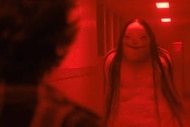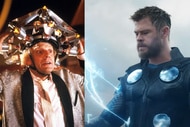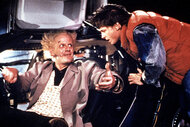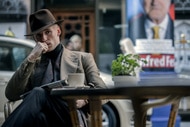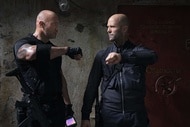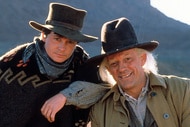Create a free profile to get unlimited access to exclusive videos, sweepstakes, and more!
20 Years Later, Lemony Snicket & Director Brad Silberling Look Back on A Series of Unfortunate Events
Time to break out the very fancy doilies!
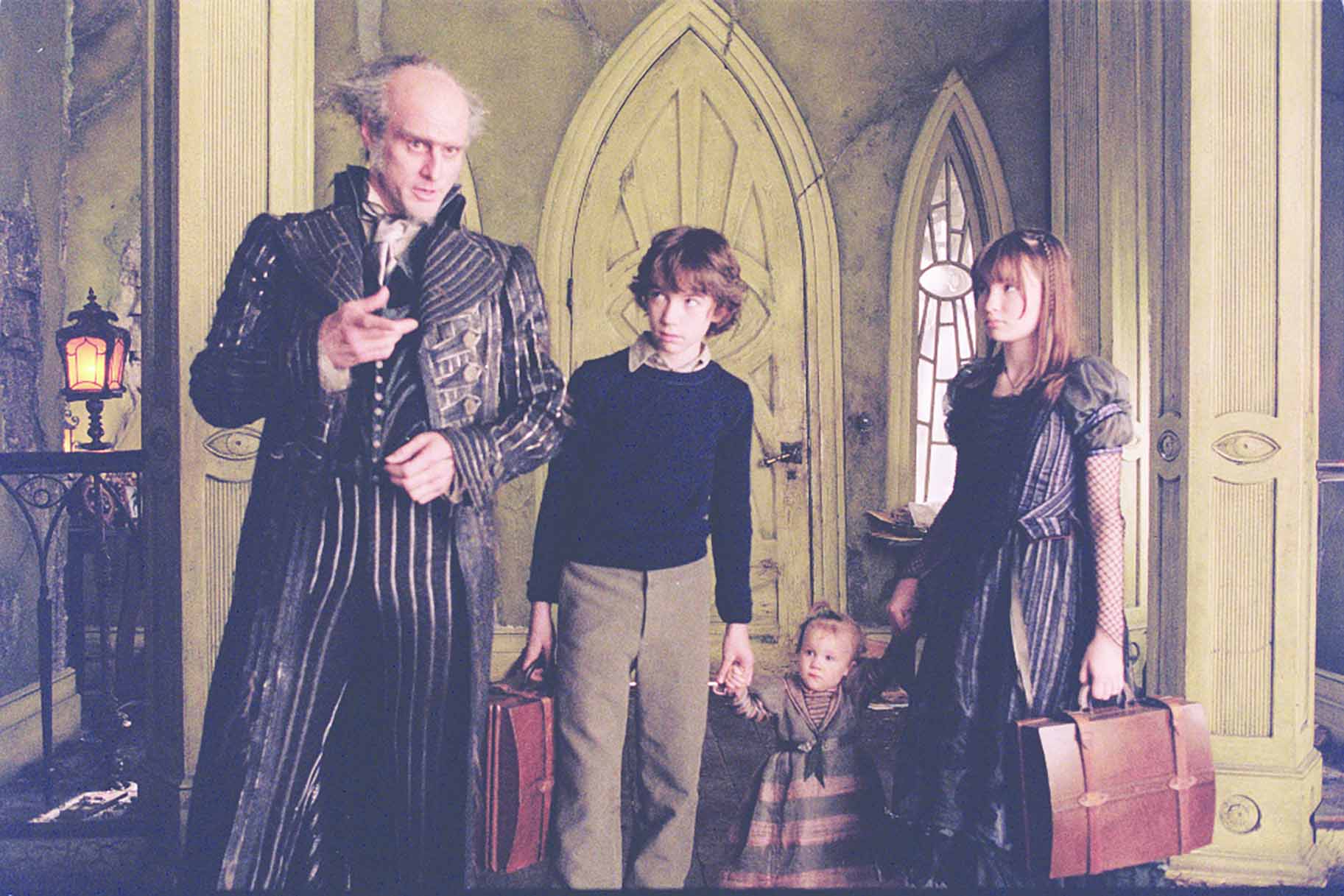
"When you look at really old stories, when you look at really lasting literature, it tends to have a flavor of terrible things going on," author Lemony Snicket (also known as bestselling author Daniel Handler) tells SYFY WIRE over Zoom. "I think it's remarkable and I think about it every time I read a realistic novel. Beowulf is what survived. We don't have books about how people felt about getting married — we have books about monsters that come in and destroy people."
Dour? Yes. But it's also the kind of logic that helped turn Mr. Snicket into a worldwide phenomenon through his calamitous compendium of 13 books that make up A Series of Unfortunate Events. The sepulchral saga of the three Baudelaire orphans — Violet, Klaus, and Sunny — and the avaricious Count Olaf struck a major chord with young readers, successfully juggling mature concepts, witty humor, sought-after sugar bowls, and secret societies. ASoUE was unlike anything else on the market, and as such, it's no wonder why Hollywood ultimately translated the mournful material into a feature film — Lemony Snicket's Series of Unfortunate Events (now streaming on Peacock and available to own on digital), which is celebrating its 20th anniversary this year.
Adapted for the screen by Robert Gordon (Galaxy Quest, Men in Black II), the movie combined the first three installments — The Bad Beginning, The Reptile Room, and The Wide Window — into a single runtime. "We all agreed that the first three books felt like an opportunity to create a through-line narrative," director Brad Silberling (Casper, Land of the Lost) explains over a separate video call. "The nature of the books is that they're episodic. That's the fun of them. Each one is like a penny dreadful."
Why Brad Silberling wanted to make a dark fairy tale for kids with 2004's A Series of Unfortunate Events
When he first inherited the project from Barry Sonnenfeld, who would later go on to adapt all 13 novels into a streaming series at Netflix, Silberling knew the darker story beats could not be ignored. While the books often killed off altruistic characters, allowed villains to escape justice, and provided only vague answers to lingering mysteries, young adult readers always came back for more. Thanks to Snicket, they slowly came to grasp that the world is not always a pleasant or rational place where adults can always be counted on to do the right thing. "[Kids] want to touch a little of the third rail," Silberling adds. "That’s the beauty of a Grimms' Fairy Tale. "There’s a dark element, but somehow, they are able to survive it; they're able to persevere. And that's obviously what the Baudelaires’ story is all about."
Anticipating that the studio bigwigs might get cold feet and want to "soften the edges" of the movie, which ended up being a co-production between Paramount and DreamWorks, Silberling decided to hold a focus group with the core demographic: kids aged 10-14.
"I actually videotaped it and basically said to them, ‘Okay, so you guys have read the books. But now we're making a movie, and the movie's for a big audience. I can't actually have [Count Olaf] kill people.' And they were like, ‘No, you have to! Olaf has to do that!’ The kids were amazing, because they just called it out, 'This is why it has to be dark, not light.' We sent that tape to Sherry Lansing [at Paramount] to try to help inoculate the movie and say, ‘We know you're going to have moments where you get scared, [but] trust it. This is your audience.'"
The goal was to make something scary, yet approachable: a surrealist, storybook world guided along by Jude Law's narration as Lemony Snicket himself. In particular, Silberling channeled The Wizard of Oz, The Night of the Hunter, and Mary Poppins for visual inspiration. "Those are a strange trifecta," he admits. "Those were my North Stars in terms of the craft of what’s in-camera [when it comes to] telling a story: forced perspective work, scenic drops, incredible detail in costume, and light."
To realize such a vision, the director assembled a top-notch crew behind the camera: production designer Rick Heinrichs; costume designer Colleen Atwood; makeup artists Bill Corso and Valli O'Reilly; cinematographer Emmanuel Lubezki; and composer Thomas Newman. Nearly all of them would nab Oscar nods for their work on the film, with Corso and O'Reilly actually taking home the gold.
After scouting a number of real-world spots across New England, Silberling and Heinrichs came to the conclusion that filming on location would not be conducive to the hand-crafted aesthetic they wanted to achieve. "We kept coming back to, ‘No, we need to control this,'" the director remembers. "'We need to control the scale, the pallet.’ We decided that we were going to need to build all of the sets."
In the end, production ended up taking over "two thirds" of the soundstages on the Paramount Pictures lot, as well as the massive Space Shuttle hangar at the now-demolished Downey Studios in Downey, California. The latter became the canvas for a number of key locations, including Briny Beach, the Last Chance General Store beside the train tracks, Damocles Dock, Lake Lachrymose, and Curdled Cave.
"I like thinking about how hard everyone worked on enormous things just because I made them up," Snicket fondly reminisces. "I remember the first time I walked onto one of the sets and they had built this huge lake. 'I thought, ‘I can't believe people are running around building a lake, just because I thought it would be fun to set something on the side of a lake.’ I find my life bewildering."
A Series of Unfortunate Events saw Jim Carrey at the height of his chameleon-like powers
Along with the brilliant craftsmanship behind-the-scenes, one of the greatest thing about the film was the casting of Jim Carrey as Count Olaf, the nefarious ne'er-do-well and failed thespian determined to get his hands on the enormous Baudelaire fortune. Wherever the siblings go, Olaf follows, donning a number of ostentatious disguises capable of fooling the buffoonish adults of this universe. Violet (Emily Browning), Klaus (Liam Aiken), and Sunny (played by twins Kara and Shelby Hoffman), however, easily see through the man's various facades.
"I just said to [Jim], ‘Listen, from my perspective, Count Olaf is the extreme version of an actor out of work,'" Silberling says of his initial conversation with Carrey. "'He is the extreme version of a guy who is not getting hired. And if he can't get hired to be in Titanic, he's going to go fund his own Titanic. If you can tap into that, then I think there's something here.’"
By that point in time, Carrey had already proven himself to be a whirlwind of physicality and range — particularly with films like The Mask and The Grinch — making him the perfect actor to comfortably slip on several identities at once. "I don't think it was ever a question," Silberling replies when asked if anyone else was considered for the part. "He started as an impressionist on top of being a good comedian, and he is a true character actor. If you look back at all the different [roles he’s played], whether it's Ace Ventura or The Mask, they’re characters, and that's where he lives. He loved the idea of being able to be a chameleon."
The two would then workshop the personas of Stefano (The Reptile Room) and Captain Sham (The Wide Window) during hair, makeup, and wardrobe tests, with Silberling asking Carrey questions while the actor was in character.
"I wanted to learn more about those characters beyond what little there is in the books," the director continues. "Plus, it gave us time to play. I would be asking Captain Sham about his thoughts on public education, or you name whatever insane things, just to prime the pump and see what happened. Jim had a blast, because it was just great improv. We went through the improv and called out the strongest, best storytelling moments, and weirdest, funniest moments. In many cases, those are what are in the movie for his characters."
In addition to Carrey, Lemony Snicket's A Series of Unfortunate Events featured an insanely stacked supporting cast of Timothy Spall, Meryl Streep, Billy Connolly, Catherine O'Hara, Cedric the Entertainer, Luis Guzmán, Jennifer Coolidge, Craig Ferguson, Jude Law, and Dustin Hoffman.
Why didn't the A Series of Unfortunate Events movie get a sequel?
Lemony Snicket's A Series of Unfortunate Events hit the big screen on December 16, 2004 — just in time for the Christmas and New Year's holidays — to favorable critic reviews and an eventual box office haul of $211 million worldwide against a not-insubstantial budget of $140 million. Given the film's $71 million profit, however, Silberling was hopeful a sequel would be green-lit at once and he'd regularly check in with the producers with ideas on how he wanted to tackle the subsequent novels. "In my mind, I think [Book 5] The Austere Academy is its own movie," notes the director. "It's like The Great Escape. It's a fantastic story, good antagonist, great sequences. I said, 'I think through this series, you'll have some that can happen in one movie, or you may be compressing more [in others].’"
Showing off the twisted and dark sense of humor that made him a bestselling author in the first place, Snicket admits he really wanted to mess with audiences in the unmade second movie. "I thought it would be fun to just go immediately to a third movie," he says. "Then you would have all this missing information and drive people crazy. You’d maybe have a couple of flashbacks that would show old scenes for the movie, so that [viewers] would think, ‘I can't believe I haven't seen that!’ That seemed more fun to me."
Unfortunately, DreamWorks and Paramount could not bridge the gap over contentious issues like budget and distribution. Silberling says he attempted to break the studio logjam by proposing an animated sequel, which would cost significantly less than live-action. "I was like, 'What if the next movie's stop-motion? What if ... Lemony comes in and tells you the first movie was really like a dramatization?' [He says], 'Unfortunately, now I need to tell you the real thing,' and then the real thing ends up being stop-motion or 2D, which I thought would be a really fun solution. We couldn't even do that."
The biggest crime of all was the fact that Carrey never got the chance to try his hand at the many other disguises Olaf assumes across the next 10 books. One could only imagine what he'd do as receptionist Shirley (The Miserable Mill), turban-wearing Coach Ghenghis (The Austere Academy), and beatnik Detective Dupin (The Vile Village). "I can't shake the feeling that he’s actually done them all just in the privacy of his own home," jokes Snicket. "But yeah, he had a madcap determination to really do that. I think he felt a connection to someone who pretends to be someone else all the time. I think that spoke very powerfully to him."
"He was so ready and looking forward to it," echoes Silberling. "It's the strange thing where everybody's in the dugout going, ‘He we go,’ and then suddenly, the lights go off..."
Lemony Snicket's a A Series of Unfortunate Events is now streaming on Peacock.





